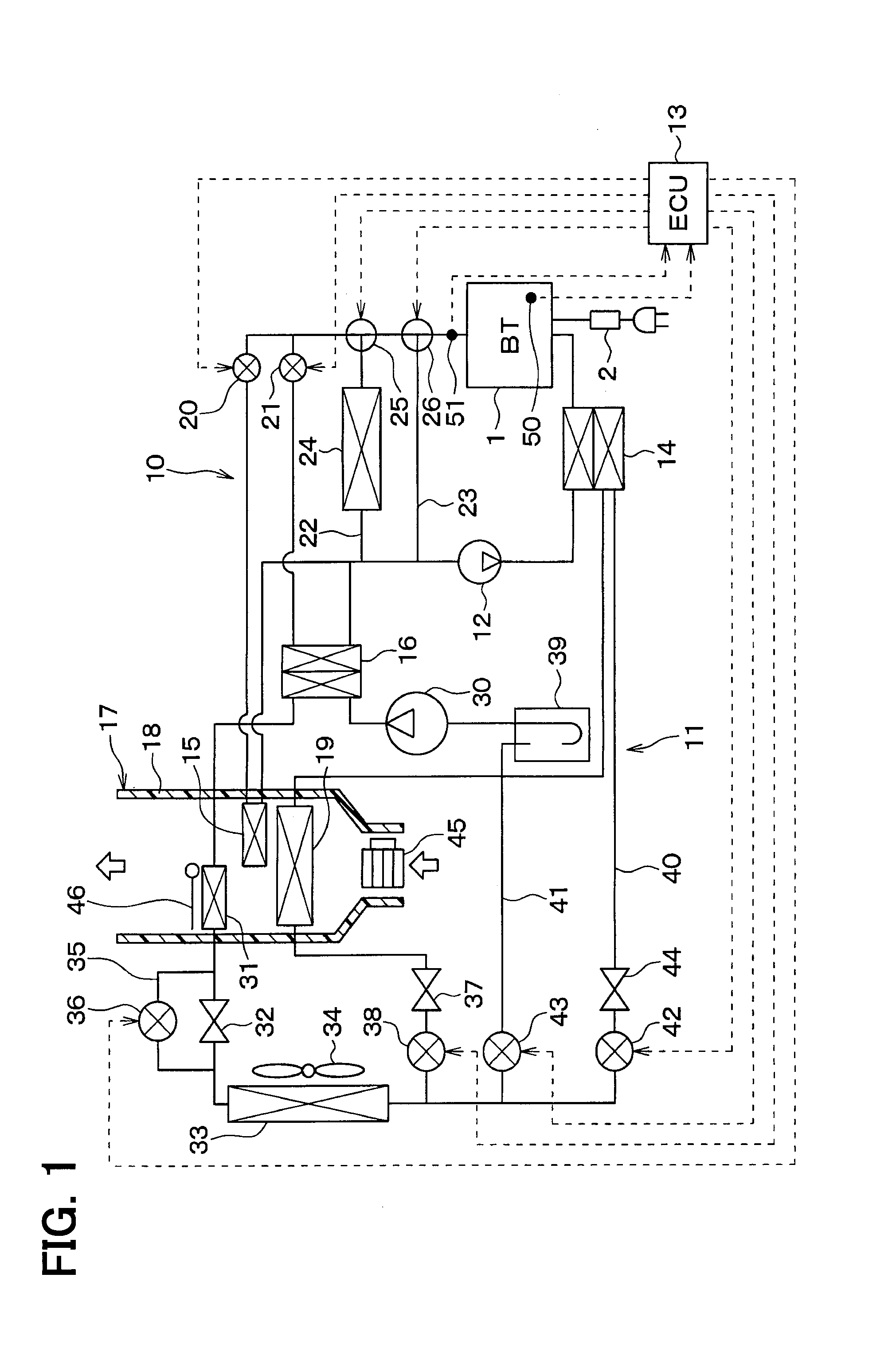Vehicle temperature control apparatus and in-vehicle thermal system
a temperature control apparatus and in-vehicle technology, which is applied in the direction of lighting and heating apparatus, battery/fuel cell control arrangement, instruments, etc., can solve the problems of increasing the weight of the vehicle, reducing the cruising range of the electric vehicle, and a large installation space in the vehicle, so as to reduce the energy used to drive the compressor which constitutes the air-conditioning device, the degree of supercooling of the refrigerant coming out of the condenser is increased
- Summary
- Abstract
- Description
- Claims
- Application Information
AI Technical Summary
Benefits of technology
Problems solved by technology
Method used
Image
Examples
first embodiment
[0052]The first embodiment is described in the following. FIG. 1 is an overall schematic diagram of a temperature control apparatus for vehicles in the present embodiment. The temperature control apparatus for vehicles in the present embodiment is used as a vehicular air-conditioner, and uses air in a vehicle compartment as a temperature control object.
[0053]Specifically, the temperature control apparatus for vehicles in the present embodiment is used as a vehicular air-conditioner of a plug-in hybrid vehicle (i.e., an electric vehicle). The plug-in hybrid vehicle is a vehicle which can charge an electric power supplied from an external power supply (i.e., a commercial power supply) at a time of stop of the vehicle to a secondary battery (i.e., a high-voltage battery), from among hybrid vehicles that derive a drive power for a travel of the vehicle from both of an internal combustion engine and an electric motor for a travel of the vehicle.
[0054]In addition, the temperature control ...
second embodiment
[0157]Although the above-described first embodiment is presented as an example configuration in which the refrigeration cycle 11 serves as a heat pump cycle that is usable for both of the heating operation and the cooling operation, a refrigeration cycle 11 in this second embodiment of the present disclosure is used as a cooler cycle for the cooling operation of the vehicle compartment, as shown in FIGS. 10 (a), (b), (c).
[0158]More specifically, in the second embodiment, the interior condenser 31, the air amount adjustment door 46, the first expansion valve 32, the expansion valve bypass passage 35, the first electromagnetic refrigerant valve 36, the second bypass refrigerant passage 41, and the fourth electromagnetic refrigerant valve 43 described in the above-described first embodiment are now omitted.
[0159]In an example of FIG. 10 (a), the second coolant-refrigerant heat exchanger 16 is disposed in the refrigeration cycle 11 between the exterior heat exchanger 33 and the second a...
third embodiment
[0161]The third embodiment further adds an inner heat exchanger 47 to the examples of the above-described second embodiment, as shown in FIGS. 11 (a), (b), (c).
[0162]The inner heat exchanger 47 is used for heat exchange between the high-pressure refrigerant flowing out of the exterior heat exchanger 33 and the low-pressure refrigerant flowing out of one of the first coolant-refrigerant heat exchanger 14 and the interior evaporator 19. Thus, the inner heat exchanger 47 cools the high-pressure refrigerant flowing out of the exterior heat exchanger 33, for realizing an enthalpy reduction function for reducing an enthalpy of the refrigerant that flows into the interior evaporator 19 and for realizing a liquid compression suppression function for preventing a liquid compression in the compressor 30 by raising an enthalpy of the sucked refrigerant to be sucked into the compressor 30 to a level that makes the sucked refrigerant of the compressor 30 to be in a gas phase.
[0163]In an example ...
PUM
 Login to View More
Login to View More Abstract
Description
Claims
Application Information
 Login to View More
Login to View More - R&D
- Intellectual Property
- Life Sciences
- Materials
- Tech Scout
- Unparalleled Data Quality
- Higher Quality Content
- 60% Fewer Hallucinations
Browse by: Latest US Patents, China's latest patents, Technical Efficacy Thesaurus, Application Domain, Technology Topic, Popular Technical Reports.
© 2025 PatSnap. All rights reserved.Legal|Privacy policy|Modern Slavery Act Transparency Statement|Sitemap|About US| Contact US: help@patsnap.com



